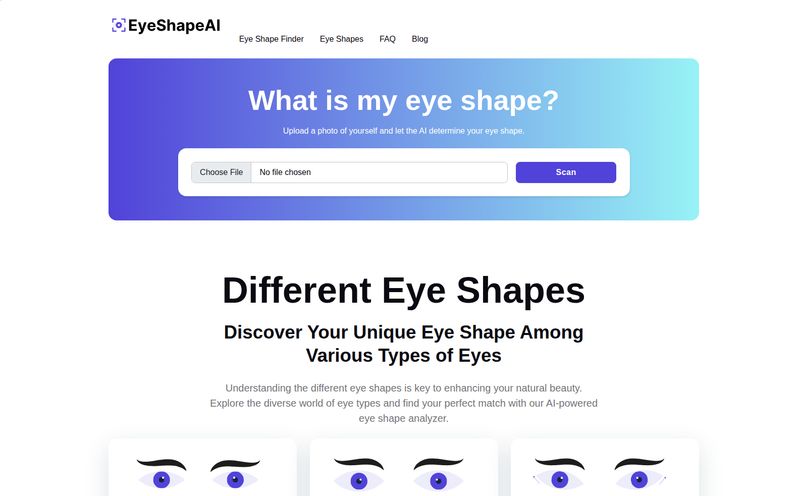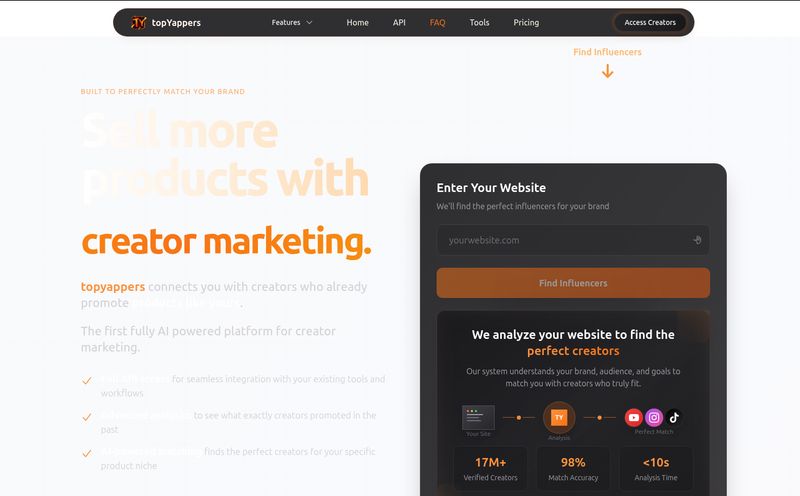I got fooled last week. Royally fooled. It was that now-infamous picture of the Pope in the slick white puffer jacket. You know the one. I saw it, chuckled, and scrolled on, assuming it was just another bizarre celebrity moment. It wasn't until I saw a breakdown on Twitter that the penny dropped. It was 100% fake, a creation of Midjourney. And for a moment, I felt a little silly. As someone who lives and breathes digital content, I should have known better, right?
But that's the thing. It's getting hard. The tech is moving at a breakneck pace, and the line between a photograph and a pixel-perfect prompt is dissolving faster than an ice cube in July. For those of us in SEO, marketing, and content creation, this isn't just a party trick. It's a foundational challenge to authenticity, brand trust, and even the basic reliability of the content we work with daily. So, when I stumbled upon a tool called RealorAI, which claims to train you to spot these fakes, my interest was more than just piqued. It felt necessary.
So What Is This RealorAI Thing Anyway?
At its core, RealorAI is wonderfully simple. It's a digital dojo for your eyeballs. It presents you with a series of images and asks a straightforward question: Real or AI? That's it. It’s a game, an interactive test designed to sharpen your instincts. Think of it less like a stuffy textbook and more like a batting cage for your critical thinking skills. Instead of fastballs, it’s throwing hyper-realistic portraits and impossibly beautiful landscapes at you, challenging you to see the subtle tells that give the game away.

Visit RealorAI
The platform is designed to help individuals and teams get a real-world feel for the current state of AI image generation. It's one thing to read about AI creating images; it’s another thing entirely to be confronted with one and have to make a call. It’s practical, it’s hands-on, and honestly, it’s a little bit humbling.
My First Round in the Ring with RealorAI
So, of course, I jumped in. The interface is clean, no fluff. Just you and the images. The first few felt easy. An image of a cat with slightly too many whiskers? AI. A landscape where the shadows just felt… off? AI. I was feeling pretty smug, I won’t lie.
Then it got tougher. A portrait of an old man, every wrinkle and liver spot seemingly perfect. A street scene in Tokyo, rain glistening on the pavement. I found myself leaning closer to my monitor, squinting, looking for the tell-tale signs I’ve trained myself to notice. The weirdly smooth skin texture, the illogical background elements, and the classic AI giveaway: messed-up hands. I caught a few, but a few definitely caught me. My final score was… well, let's just say I have room for improvement. But the process itself was the real prize. It forced me to actively look, not just passively consume, and that's a muscle we all need to build.
Why This “Game” Is a Serious Tool for Professionals
It’s easy to dismiss this as a bit of fun, but for anyone in our field, this is serious stuff. The implications of AI-generated content are massive, and we're only seeing the beginning.
For SEOs and Marketers
Brand trust is our currency. If you start using AI images on your blog or social media that look cheap, soulless, or worse, have bizarre artifacts in them, you erode that trust. Your audience might not know why it feels off, but they'll feel it. Using authentic imagery—or at least, high-quality, well-vetted AI imagery—is crucial. Furthermore, think about stock photo sites. They're already flooded with AI submissions. Being able to quickly vet an image before you license it is an invaluable skill. I don't think Google is penalizing AI content directly yet, but they are all about rewarding authentic, high-quality, helpful content. A site full of wonky AI pictures doesn't exactly scream "trustworthy expert," does it?
The Bigger Picture Beyond Our Niche
Stepping outside our marketing bubble, the need for this skill is even more stark. We're talking about the potential for sophisticated misinformation campaigns, political deepfakes, and scams. Training the general public to have a healthy dose of skepticism is a huge societal challenge. Tools like RealorAI are a small but important part of that educational puzzle. It's about promoting a new kind of digital literacy for a new era of the internet. It's teh new frontier, really.
Your Cheat Sheet for Spotting the Fakes
While playing on RealorAI, I started making a mental checklist. While AI is getting better at hiding its tracks, there are still a few common giveaways you can look for. Call it your AI-spotting field guide:
- Hands and Fingers: The classic. AI has long struggled with the complex geometry of hands. Look for too many fingers, too few, or fingers that bend in unnatural ways. They're getting better at this, but it's still a frequent flub.
- Text and Symbols: If you see any text in the background of an image—on a sign, a book, or a shirt—zoom in. AI often produces garbled, nonsensical characters that look like a language from another dimension.
- Unnatural Perfection: Sometimes, things are just too perfect. Symmetrical faces without a single flaw, skin that looks like plastic, or unnaturally clean environments can be a dead giveaway. Reality is messy; AI often forgets that.
- Weird Blending: Look at where objects meet. An earring might be fused to an earlobe, or a person's hair might blend unnaturally into the background. Physics can get a little… optional in AI land.
- The Dead Eyes: This is a subtle one. Often, AI-generated portraits have eyes that lack depth or focus. They can look glassy, vacant, or just not quite right. It's that uncanny valley feeling.
The Good, The Quirks, and The Catch-22
No tool is perfect, and my experience with RealorAI was overwhelmingly positive, but it's worth looking at the whole picture.
What I really appreciated was the interactivity. This isn’t a lecture. It’s a workout. It’s an engaging way to learn a skill that is becoming less of a niche talent and more of a basic survival skill online. It's practical and, dare I say, fun. It gamifies a critical skill, and that's a brilliant approach to learning.
The main caveat isn't a flaw in the tool itself, but a reality of the space it operates in. AI technology evolves weekly. The "tells" I listed above might be obsolete in six months. Midjourney V6 is already way better at hands than V5 was. This means any training content, including that on RealorAI, faces a constant battle against irrelevance. To stay effective, the platform will need to be constantly updated with images from the latest and greatest AI models, which is a significant undertaking.
What's the Price of This Digital Literacy?
Here’s the kicker. From what I can see, RealorAI appears to be free to use. There's no pricing page, no subscription prompt. This is fantastic, as it lowers the barrier to entry for everyone. My guess is that it might be in a beta phase or perhaps serves as a top-of-funnel tool for a larger company. Whatever the reason, you can't argue with the value proposition. Free training for a skill this important is a no-brainer.
Final Thoughts: Is It Worth Your Time?
Yes. Unreservedly, yes. Look, the internet isn't getting any more real. The AI genie is out of the bottle, and it's not going back in. We can either be passive consumers, susceptible to every clever fake that crosses our feeds, or we can be active, critical participants. We can learn the new language of digital imagery.
RealorAI isn't a magic bullet that will make you an infallible fake-spotting expert overnight. But it is a fantastic, accessible, and even enjoyable first step. It's a tool to hone your intuition and give you the confidence to question what you see. In today’s digital world, that's not just a nice skill to have. It's a superpower.
Frequently Asked Questions
- What exactly is RealorAI?
- RealorAI is a free online tool that helps you learn to distinguish between real photographs and images created by artificial intelligence. It works like a game, presenting you with various images and having you guess whether they are real or AI-generated, helping to train your eye.
- Is RealorAI free to use?
- Yes, based on our review, the tool is currently available for free. There is no pricing information or subscription wall on their website.
- Why is it important to tell real and AI images apart?
- For professionals, it's about maintaining brand trust and ensuring content quality. In a broader sense, it's a vital digital literacy skill to combat misinformation, deepfakes, and online scams, ensuring you can critically evaluate the visual information you consume.
- Can't I just use a software tool to detect AI images?
- While some AI detection tools exist, they are often unreliable and can be easily fooled. As AI image generators improve, these detectors struggle to keep up. Learning the fundamental human skills to spot anomalies is often a more reliable, long-term strategy.
- How often is the content updated on RealorAI?
- This is a key challenge for any such platform. For RealorAI to remain effective, it would need to be updated regularly with images from the newest AI models (like DALL-E 3, Midjourney V6, etc.). The rapid evolution of AI makes this a constant race.
- What are the most common signs of an AI-generated image?
- The classics include errors in complex details like hands and fingers, garbled text in the background, unnatural skin textures, objects blending weirdly, and eyes that can appear glassy or unfocused. However, be aware that AI models are rapidly improving at fixing these flaws.


